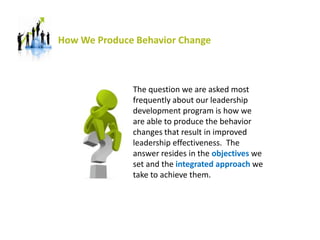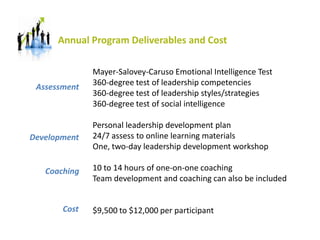A Solution to the Leadership Development Challenge
- 1. Intelligent Leadership Styles A Solution to the Leadership Development Challenge
- 2. There is a Compelling Value Proposition for Leadership Development! We are recommending an annual program of leadership development program for six to eight senior leaders that includes assessment, development, and coaching that can have a 6 times the cost impact on your bottom line. Leadership development can be cost-effective, not just costly!
- 3. The Value Proposition for Leadership Development Out of pocket cost Time away from work Greater discretionary effort Higher levels of engagement Better customer service Improved teamwork More creativity and innovation Less turnover
- 4. Our Value Proposition for Building Leadership The leadership development program we recommend is focused on producing higher levels of engagement and greater discretionary effort across the organization resulting from improved leadership effectiveness.
- 5. Engagement and Discretionary Effort Engaged staff members understand and embrace organizational objectives as well as the strategies to achieve them, with clear evidence of trust based on mutual respect and a collaborative work environment all of which sum to produce high levels of discretionary effort.
- 6. 28% are Actively Engaged and “in the game” of achieving performance objectives. 54% are Not Engaged and “sitting on the sidelines” performing only to keep their jobs until retirement or a better job comes along. 18% are Actively Disengaged and disruptive from time to time. What Proportion of Staff Members are Engaged? There have been dozens of research studies on this topic. What you see below is an estimation of “typical” levels for U.S. worker engagement.
- 7. The “Want to Do” and “Have to Do” Curves Leading by issuing orders and directives will produce only “compliance behaviors” with little discretionary effort. While this leadership style will produce compliance, it produces quite low levels of discretionary effort – and performance! The primary objective of the leadership program we recommend is to improve the discretionary effort of your staff.
- 8. Discretionary Effort Discretionary Effort extends beyond what is minimally required to keep your job up to maximum physical and mental effort in pursuit of performance objectives. Actively Engaged workers (28% of staff) use high levels of discretionary effort to achieve personal performance objectives and to collaborate with others to achieve team objectives. Not Engaged workers (54% of staff) are simply doing what is required to keep their jobs. They occasionally display some discretionary effort but they rarely help others, , take risks and always “stay under the radar.” Actively Disengaged workers (18% of staff) are either acting “retired on the job” or disrupting the work of other staff members.
- 9. Research on the Current State of Discretionary Effort Impact Achievement Group research states “The average American employee feels that the effort a person has to give in order to keep his or her paycheck is about 60% to 70% of what they feel they could be giving.” Leadership IQ research indicates that 72% of employees polled admit they aren’t giving their best effort. And, in the same study, 77% of their managers agreed. Dr. Aubrey Daniels frequently expressed his belief that the difference between workers doing what they must and working as they could with maximum effort, could nearly double their output and value to their employers.
- 10. The Impact of Discretionary Effort - Profits Companies with high and sustainable engagement levels and discretionary effort had an average one year operating margin that was close to three times higher than those with lower engagement (Towers Watson 2012). Marks and Spencer’s research shows that over a four year period stores with improving engagement had, on average, delivered £62 million more sales to the business every year than stores with declining engagement. Research from organizations representing more than five million employees worldwide in the Aon Hewitt database showed that in 2010 organizations with discretionary levels of 65% or greater outperformed the total stock market index and posted total shareholder returns that were 22% higher than average; companies with discretionary levels of 45% or less had a total shareholder return that was 28% lower.
- 11. The Impact of Discretionary Effort - Productivity 85% of the world’s most admired companies believe that efforts to engage employees and improve discretionary effort have reduced employee performance problems (Hay 2010). A Gallup study (2006) looking at data from over 23,000 business units has demonstrated that those with the highest engagement scores (top 25%) averaged 18% higher productivity than those with the lowest engagement scores (bottom 25%). A Fortune 100 manufacturing company reported that quality errors were significantly higher in poorly engaged/low discretionary effort teams (DDI 2005). The RSA insurance company found that their units with higher levels of employee engagement had 35% less downtime between calls – in effect the equivalent of one ‘free of charge’ employee being added to every eight engaged employees.
- 12. The Impact of Discretionary Effort – Customer Service 78% of the more engaged/higher discretionary effort employees in the public sector felt they could impact public service delivery positively; only 29% of the disengaged felt the same way (Towers Watson 2007). Work by Serco and Aon Hewitt looking at 274 Serco client contracts demonstrated a longitudinal relationship between employee engagement and effort versus the Net Promoter Score (NPS), a measure of customer loyalty. Those contracts serviced by employees whose engagement and effort had improved over the year had NPS scores 24% higher than those employees whose engagement had declined.
- 13. The Impact of Engagement – Retention Replacing employees who leave can cost up to 150% of the departing employee’s salary. Towers Perrin reports that highly engaged organizations have the potential to reduce staff turnover by 87%; the disengaged are four times more likely to leave the organization than the average employee (Towers Perrin 2008). Gallup demonstrated that in those companies with high turnover (over 60%) those with the lowest engagement (bottom 25%) had a 31% higher turnover than those in the top quartile. According to Hay, companies with high levels of engagement show turnover rates 40% lower than companies with low levels of engagement.
- 14. Leadership Effectiveness can Drive Engagement/Discretionary Effort Focusing and accelerating the development of leaders’ emotional intelligence, social intelligence, thinking process, facilitation, and coaching skills can improve staff engagement and drive their discretionary effort.
- 15. Our Leadership Development Program Leadership Assessment Tools are needed to focus and accelerate the leadership development process. A “blended learning” approach will deliver training 24/7 through online courses as well as through workshops. One-on-one and team coaching will be used to accelerate the rate of experiential learning and behavior change.
- 16. All Leadership Development Elements are Required The absence or ineffectiveness of one or more of these elements is why so many leadership development efforts fail to produce the changes in leadership behaviors that are required to deliver higher levels of engagement and discretionary effort. Training alone typically does not produce behavioral change and it can be very expensive. Training and coaching without assessment sacrifices both effectiveness (developing the wrong skills and abilities) and efficiency (delaying behavioral change and increasing costs).
- 17. How We Produce Behavior Change The question we are asked most frequently about our leadership development program is how we are able to produce the behavior changes that result in improved leadership effectiveness. The answer resides in the objectives we set and the integrated approach we take to achieve them.
- 18. How We Produce Behavior Change Focus on Program Objectives We focus all elements of our program on improving staff engagement and discretionary effort. Research clearly indicates improving staff engagement and discretionary effort will result in a wide range of economic benefits for the organization. Thus, we focus our efforts on helping our clients to develop and apply the leadership knowledge, competencies, and behaviors necessary to improve staff engagement and discretionary effort.
- 19. How We Produce Behavior Change Focus on Interpersonal Skills and Abilities We do provide learning materials and discussion about leadership theories and models, but most of our effort focuses on developing and deploying the interpersonal skills and abilities required to put leadership knowledge to work. What makes a successful leader is what they can achieve with and through other people, which requires advanced interpersonal skills. We develop six complementary sets of critically important skills and abilities.
- 20. Interpersonal Skills and Abilities Read people by accurately interpreting the emotional content in their faces, body language, and non-verbal communication. This includes the ability to assess how well other persons accept your ideas and points of view. Connect with people, primarily through empathy, reflective listening and then form trusting relationships that are the foundation of work environments that feature engagement and collaboration. Engage people through questioning and responding appropriately to their ideas and emotional states.
- 21. Interpersonal Skills and Abilities Influence the attitudes, abilities, and actions of others through constructive communication strategies, coaching, applying nurturing behaviors while avoiding toxic ones. Think more effectively with others in pairs (using the Thinking Partners method) and a by facilitating small group thinking processes in an enriched Thinking Environment. Shape behaviors using the principles of Applied Behavior Analysis to implement change faster and more effectively as well as manage performance to better achieve objectives.
- 22. Efficient and Personalized Our development program is highly efficient because our assessment program clearly defines our starting point and we have clear performance objectives in mind (engagement and discretionary effort). Because each leader will ultimately develop their own unique blend of leadership style and interpersonal skill set, the one-on-one approach we use is essential to achieve the economic benefits to the organization we seek to achieve. The basic development process and performance objectives are well-defined, but each development journey is unique.
- 23. Annual Program Deliverables and Cost Mayer-Salovey-Caruso Emotional Intelligence Test 360-degree test of leadership competencies 360-degree test of leadership styles/strategies 360-degree test of social intelligence Personal leadership development plan 24/7 assess to online learning materials One, two-day leadership development workshop 10 to 14 hours of one-on-one coaching Team development and coaching can also be included $9,500 to $12,000 per participant Assessment Development Coaching Cost
- 24. Do-It-Yourself? Few organizations are satisfied with their leadership development efforts. To be fair to the HR staff in most organizations, effective leadership development requires the contributions of professionals with highly specialized backgrounds and certifications – not HR Generalists or Trainers. As a result, leadership development often involves sending leaders to expensive off-site training programs and/or in-house workshops. These often extend leaders’ knowledge of leadership theories, but do not produce behavior change or drive leadership effectiveness. Few organizations can justify employing full-time coaches to work with leaders and most external coaches are primarily interested in maximizing their coaching hours and revenues. Do-It-Yourself leadership development is not cost/effective for most organizations, so outsource this critically important program!
- 25. The Value Proposition for Outsourcing Leadership Development Can Be 6 to 1 or Even Greater A reasonable annual cost for our firm to provide comprehensive leadership development services for six of your leaders is about $65,000 (we typically charge between $9,500 to $11,500 per leader annually for this program). This should produce significant improvements in engagement and discretionary effort because these are the what our development program is designed to achieve. What if, as a result, we achieved just a 10% improvement in staff productivity, a 10% improvement in customer satisfaction, and 10% improvement in retention? These not unrealistic outcomes from our leadership development program. Could this improvement result in at least a $400,000 improvement in your bottom line? We believe so and assuming it does, then we have a 6 to 1 value proposition.
- 26. Questions? Contact: Dr. Phillip R. Ash professorash@ymail.com Intelligent Leadership Styles


























